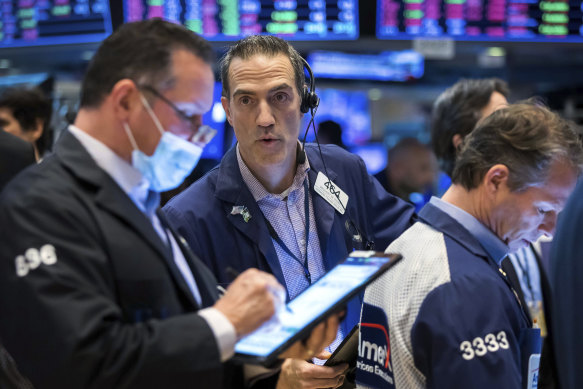This was published 2 years ago
Opinion
Playing with fire: Why markets have been engulfed in chaos
Stephen Bartholomeusz
Senior business columnistThe bigger they are the harder they fall. That’s a truism that helps explain the chaos in crypto markets and at the big end of the market for technology stocks.
While there are always specific circumstances to explain why companies or their share prices collapse there’s also a macro explanation when whole sectors rise and fall.

Tech stocks have had a decade of glory but the bubble is deflating. Credit: NYSE
Some of those specific circumstances are messy and ugly.
The collapse of Sam Bankman-Fried’s FTX group last week – a crypto exchange valued at $US32 billion ($48 billion) earlier this year – is particularly messy and ugly, with allegations that $US10 billion of customers’ funds were transferred to his own hedge fund and apparently lost and $US500 million-plus being hacked or stolen last week.
The collapse of the group has sent shockwaves throughout the crypto sector, which has lost about $US200 billion, or 20 per cent, of its market capitalisation in the past week.
In a different fashion Elon Musk’s disastrous acquisition of Twitter for $US44 billion is equally messy and ugly, without the stench of something sinister. Hubris and incompetence might be the better explanation.
He’s sacked half Twitter’s 7500 staff (and tried to rehire some of them when he realised they were vital for the business), cut 4400 of its 5500 contractors, scared off the advertisers who are Twitter’s only source of revenue and has said Twitter is losing $US4 million a day and could face bankruptcy.
The senior debt within the $US13 billion of borrowings for the acquisition has been valued at only 60 cents in the dollar, which implies that not only are his bankers underwater but the $US33.5 billion of equity – $US26.5 billion of it Musk’s own money – is worthless.
Even the titans of the tech sector – Amazon, Meta Platforms (Facebook’s parent), Microsoft, Alphabet (Google’s parent) and, to a lesser extent, Apple – have seen their share prices tank.
Amazon is reportedly making about 10,000 of its employees redundant, Facebook about 11,000, Microsoft “less than one per cent” of its employees and Apple is freezing hiring of new employees in a reversal of two decades of growth trajectories.

The demise of FTX has put a big question mark on the whole crypto sector. Credit: AP
Big tech had a good pandemic as lockdowns, the shift to working from home and a big increase in consumer cash balances thanks to governments’ “relief” and stimulus spending sparked a tech-biased investment and spending spree.
But tech companies had actually had a good decade or more, thanks to the central banks response to the 2008 financial crisis, a response magnified when the pandemic hit.
The US Federal Reserve, for instance, expanded its balance sheet and pumped cash into the US and global financial system to keep it functioning in the face of the financial crisis.
Its “quantitative easing” – purchases of bonds and mortgages – was left in place for nearly a decade before it started to shrink a balance sheet that had swollen from about $US900 billion pre-crisis to about $US4.5 trillion in 2018.
With liquidity sloshing through all markets and risk-taking apparently underwritten by the central banks it wasn’t only valuations that were pumped up. The apparent environment of negligible interest rates out into the distant future and the deluge of cash encouraged investors to accept ever-increasing risk.
When the pandemic struck, the quantitative easing program was re-started and that balance quickly ballooned to about $US9 trillion before the Fed ended it and, in September, began what will be a years-long process of returning to more normal settings.
The other major central banks – and some, like the Reserve Bank, not as major – all did similar things. Tens of trillions of near-costless dollars were pumped into the global financial system and had to find somewhere to go. In real (after inflation) terms, for much of the past decade, investors have been paid, or at least subsidised by the central banks, to take risk.
Interest rates have remained at historically low levels since the financial crisis. In the US, for instance, the yield on two-year Treasury notes three years ago was 1.6 per cent and the yield on 10-year bonds only 1.8 per cent.
The latter is significant because the “risk-free” rate is commonly used by investors to discount the future cash flows of companies to calculate their net present values. The lower the rate the more valuable those cash flows well into the future will be.
Unsurprisingly, given that tech companies tend to have the most growth built into analysts’ assumptions and that the big techs seemed to have infinite growth prospects, they were the major beneficiaries.
Between late 2019 and late last year (the tech sector peaked last November) the overall US sharemarket rose about 53 per cent. The tech-heavy Nasdaq market rose 88 per cent over the same period and the NYFANG index (which contains the mega techs like Facebook, Amazon, Apple and Google) rose a staggering 170 per cent.
With liquidity sloshing through all markets and risk-taking apparently underwritten by the central banks it wasn’t only valuations that were pumped up. The apparent environment of negligible interest rates out into the distant future and the deluge of cash encouraged investors to accept ever-increasing risk.
Bitcoin’s price rocketed more than 300 per cent, from less than $US9000 to almost $US70,000 from late 2019 to late 2021, and the wider market for crypto assets exploded, with the market capitalisation of the entire crypto universe soaring from about $US230 billion in 2019 to about $US3 trillion in late 2021.

The value of Twitter is sinking by the day. Credit: AP
In March this year, as the Fed started raising interest rates and foreshadowed the shrinking of its balance sheet in response to a sharp spike in US and global inflation – ignited by a combination of the impact on the pandemic on global supply chains and the central banks and governments over-doing of their monetary and fiscal responses to COVID-19 – the bubbles in asset markets started deflating.
Interest rates started rising. Two-year US Treasuries now yield 4.3 per cent and 10-year bonds – the benchmark for company valuations – 3.9 per cent, having been above 4 per cent in the past week.
The US sharemarket is now down almost 20 per cent from last year’s highs, Nasdaq about 30 per cent and the NYFANG index 42 per cent. What went up most has come down most and essentially almost all of the pandemic-era gains have been erased.
For a leveraged buyout like Musk’s buyout of Twitter, that implosion of value – he paid a premium over a pre-bust price for a loss-making company whose income he has since reduced by his own actions and whose interest bill will go from less than $US100 million to more than $US1 billion thanks to the buyout debt – is an existential threat.
For other big and small techs, it means unhappy shareholders, a problem with the stock-based employee compensation that tech companies tend to use heavily, the decimation of their founders’ wealth and, if they need to raise new equity, far more expensive capital. For investors in the private tech space, it means slashed mark-to-market valuations.
The dramatic shift in crypto asset value may have played a role in the demise of FTX – it may have used customer funds either for high-risk trading in Bankman-Fried’s hedge fund, Alameda Research, or to bail out Alameda for losses on that trading – but the combination of the plunge in values and the continuing scandals, hacks and frauds that plague the sector add another dimension to the broader pressures on higher-risk assets and higher earnings-multiple stocks.
An end to this cycle of rising interest rates might put a floor under the stockmarket and help reinflate, to some degree, the mega techs’ share prices. The world of crypto will, however, need to regain some credibility, and probably significantly more regulatory oversight, before its prospects appear brighter.
The Market Recap newsletter is a wrap of the day’s trading. Get it each weekday afternoon.